Types of Plums: Black, Red, and More Varieties (With Pictures) – Including Plumcots, Apriums, and Pluots

Plums are delicious fruits that grow on trees and are classified in the genus Prunus. Plum fruits are a type of drupe because they have a stone in the middle that’s surrounded by soft, sweet or tart flesh. There are around 40 species of plums, and a single plum tree can yield around 100 lbs. (45 kg) of medium-sized fruits.
Plums are a type of stone fruit that can have oval or round shape. They can have black, purple, red, or yellow colored skin. Inside, the flesh of plums is soft and juicy, and it usually has an amber color. Sweet black plums are often dried to create prunes. Mature plum fruits have a dusty-white waxy coating making them appear pale gray or bluish-green.
Depending on the variety of plum, a single plum measures between 0.7” and 2.7” (2 – 7 cm).
Plums are usually categorized into Japanese plums (Prunus salicina) and European plums (Prunus domestica). Japanese varieties tend to be oval- or heart-shaped and come in yellow, black, or red varieties. These types of plums have firm flesh and are often eaten fresh. Types of European plums are usually very sweet with juicier flesh and are used in baking or for making jams and jellies.
There are many varieties of plums ranging in taste from sweet to tart. Some types of plums have a red sour flavored-skin that surrounds sweet juicy yellow flesh. Other varieties of plums are extremely sweet with dark purple skin and amber-colored flesh.
Some of the types of plums include:
- Moyer plum. This common plum has sweet taste. It has purple skin with juicy yellow-orange to amber flesh.
- Damsons plum. Popular tart-flavored plum with dark purple skin and yellowish green flesh.
- Elephant Heart plum. This type of sweet Japanese plum has dark red to purple mottled skin and sweet juicy red flesh.
- Greengage plum. Green type of plum with a delicious honey-sweet taste.
- Myrobalan plum. Small round plum that looks like red or yellow cherry.
- Santa Rosa plums
- Blood plum
Before looking at the many varieties of plums and prunes, let’s look at some of the delicious plum hybrid fruits that are popular.
Plums, Plumcots, Apriums, and Pluots
Plums are related to other drupes such as apricots, peaches, and nectarines. Growers can cross these types of fruits to create new types of deliciously sweet stone fruits. Plumcots, apriums, and pluots are all naturally developed fruits that combine varieties of plums and apricots.
Here’s a brief description of these plum hybrids:
- Plumcots—A cross between apricots and plums that are half plum and half apricot. These fruits have the shape of apricot but the skin color and sweet taste of plums.
- Apriums—These drupes have more apricot than plum and have fuzzy skin similar to apricots. Just like apricots, they have sweet orange flesh.
- Pluots—These stone fruits are more plum than apricot. They look like red apricots and have a distinct taste of plum.
Types of Plums (With Pictures and Common Name)
Let’s look in more detail at the various types of plums that are common in local stores. You will find out about the best plums for eating fresh and about the ones that are tastiest in cooked and baked food.
Moyer Plums
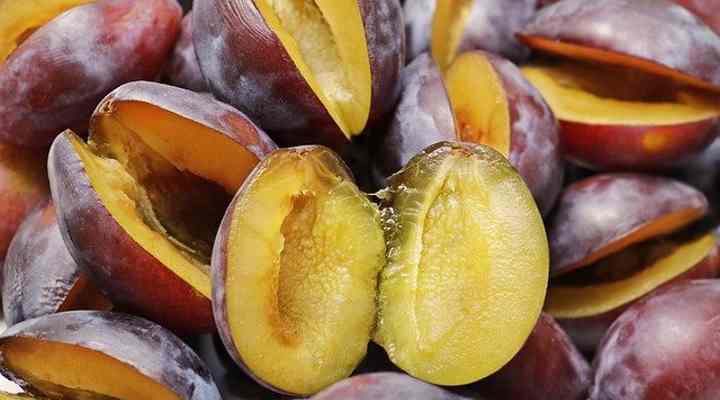
Moyer plums are a common purple plum and one of the most popular varieties. These are extremely sweet plums that have dark burgundy to purple skin and juicy yellow-orange to amber flesh. This plum variety is considered one of the best European plums for its shape and taste. Moyer plums are large plums with a long oval shape and high sugar content. This species of plum is delicious fresh and is often dried to create sweet prunes.
Moyer plums tend to ripen late in the season. You can tell if the plums are ripe by gently squeezing the skin. Your fingers should leave a slight indentation if the fruit is ripe. If the flesh feels hard or doesn’t give slightly, you need to wait until it ripens.
Damsons
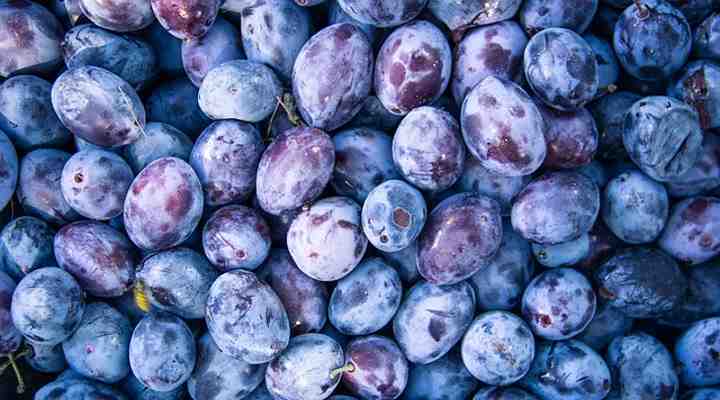
Damsons are a popular dark-skinned European variety of plum that has tart-flavored flesh and skin. Unlike many other varieties of plums, damsons are high in sugar with an astringent taste. The purple-blue skin covers firm yellowish-green flesh that has a sour taste. This sweet and sour taste combination makes damson plums excellent for using in savory or sweet dishes to add a bit of tartness.
Damsons are usually ripe for harvesting from late August until October. There are several cultivars in the damson subspecies Prunus domestica insititia. Some popular cultivars are ‘Blue Violet,’ ‘Shropshire Prune,’ Common Damson,’ and ‘Frogmore.’
Elephant Heart Plum
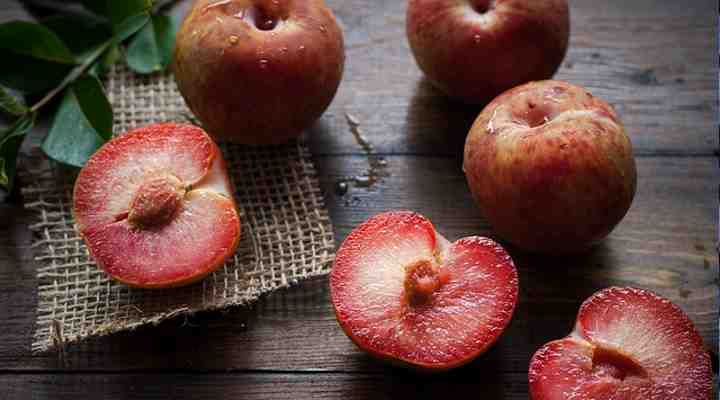
As its name suggests, the elephant heart plum is a large, heart-shaped stone fruit. Dark red to purple mottled skin covers sweet juicy red flesh that has a firm texture. This plum variety is classified as a Japanese plum variety, and they taste delicious when eaten fresh. The flesh is so soft and juicy that some say it’s almost like drinking juice.
These sweet plums have a wonderful balance between sweetness and tartness. The red flesh is tart and sweet, and the skin tastes like berries. Elephant heart plums are generally ready for picking between September and October.
Greengage Plum (Prunus domestica)

The greengage plum is one of the few green varieties of plums when they are ripe. The plums are small and round and have a delicious honey-sweet taste. The juicy flesh has a firm texture that is common with many European plums. Depending on the greengage plum cultivar, the green skin can have hints of red blushing or yellow on it. Many consider greengage plums as the best plums to use in desserts.
Greengage plum trees blossom in spring, and the bumper crops are ready by late summer and early fall. It’s at this time when the fruits are at their sweetest. This popular European variety is a clingstone plum, meaning that the skin clings to the pit.
Myrobalan (Cherry Plums)
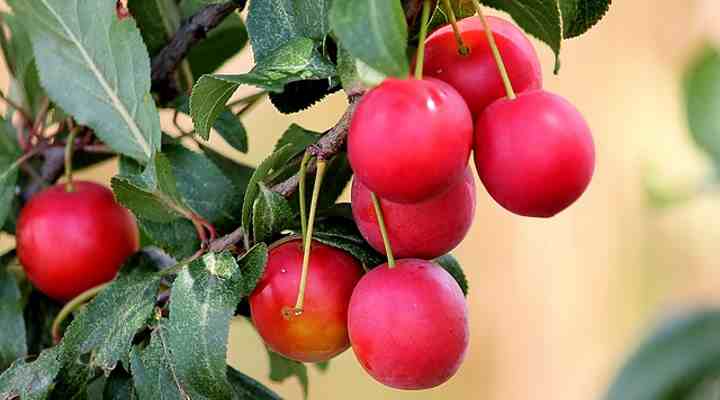
Myrobalan plums are small round fruits that look like red or yellow cherries. There are several different cherry plum cultivars that produce small plums ranging in taste from sweet to tart. The sweet varieties of Myrobalan plums are delicious when eaten fresh. The tarter cultivars are suitable for using in baking or making jellies.
Apart from growing small cherry-like plums, these plum trees are popular backyard ornamental types of fruit trees. The plum trees can grow as small garden shrubs or small decorative fruit trees. They are also one of the first trees to flower in spring.
Santa Rosa

‘Santa Rosa’ plums are drupes that have reddish-purple skin with juicy strawberry-colored flesh. These medium- to large-sized plums have a round shape. Biting into ‘Santa Rosa’ plums reveals a thin skin that covers plump, juicy flesh. There is hardly any tartness in the taste, and many say that the sweet taste is reminiscent of cherry-flavored fruit punch.
Santa Rosa plums are suitable for many uses, including eating fresh or using in baked goods.
Satsuma (Blood Plum)
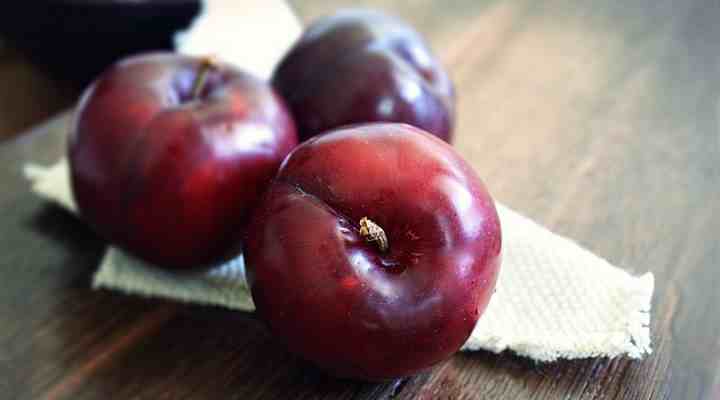
Satsuma plums are a Japanese variety of medium to small red round plums. The maroon skins on this plum variety tend to be firm and tough with a sour flavor. However, the deep red-colored flesh is very sweet that offsets the bitter-tasting skin.
Although called a satsuma plum, they have nothing to do with the citrus fruit. The common name blood plum refers to the deep red color of the skin and flesh. Satsuma plums are a semi-clingstone variety, meaning that the flesh partially clings to the stone. These Japanese plums tend to be larger in size than European red plums.
Simca Plums

Simca (simka) plums are a variety of large, heart-shaped plums that have deep reddish skins with blueish-purple dusty waxy coating. The dark-red skin covers golden-yellow flesh that has a pleasantly sweet flavor.
As with most Japanese varieties of plums, Simca plums are larger and juicer. These delicious plums are best eaten fresh due to their juicy flesh.
Mirabelle Plums
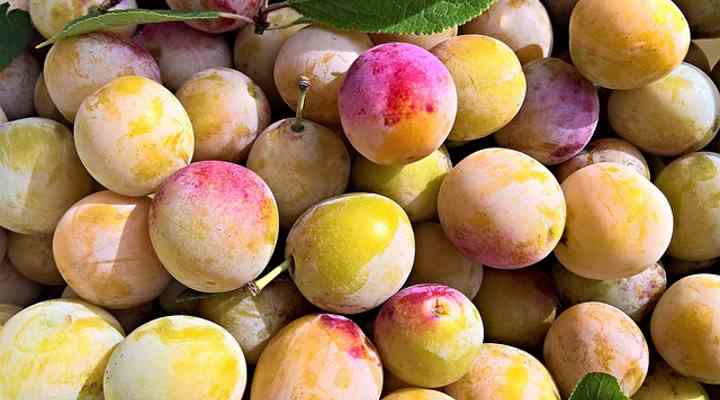
Mirabelle plums look similar to apricots as they have bright yellow-orangey skins. These sweet plums are sometimes called Mirabelle prunes or cherry plums. Cutting open the soft skin reveals sweet amber flesh and a stone in the middle. Their high sugar content means that these round fruits are excellent for making jellies, jams, and baked goods.
It’s rare to find these plum trees growing outside of France. Also, the soft flesh of the fruit means that it doesn’t travel well, so you will usually only find these plums sold in France. However, you can plant Mirabelle plum trees in your garden if you want to grow some of the sweetest plums available.
Varieties of Sweet Black Plum (With Pictures)
Black plums get their name from the dark purple skin that surrounds their flesh. Many of the fresh plums sold in stores and supermarkets are types of Japanese black plums. They are prized for their sweet taste, golden yellow flesh, and lack of tartness.
Black Ruby

One of the most popular types of black Japanese plums is the ‘Black Ruby’ cultivar. This juicy plum has reddish-black skin that surrounds yellow flesh. This round plum is one of the few sweet plum varieties that ripens in mid-summer.
One of the reasons why this type of plum is a popular variety for eating fresh is that it’s a freestone variety. You can bite into the sweet flavorsome flesh and the stone comes away fairly easily. Most Japanese black plums are clingstone varieties.
Friar
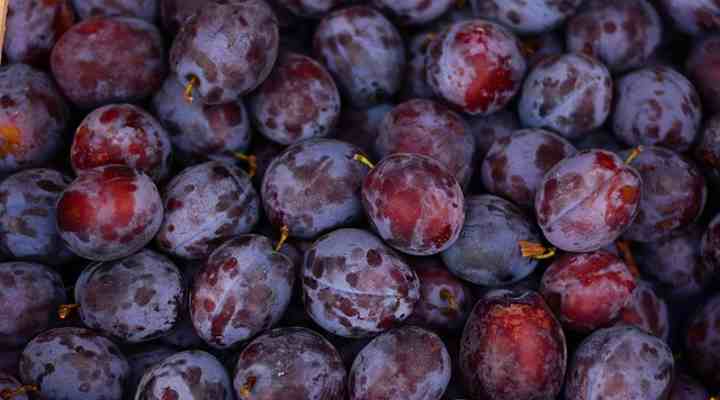
‘Friar’ plums are popular large Japanese plums with sweet, juicy flesh. The skin on these round plums is a dark purple color with hints of a blue dusty wax coating. These sweet plums have light orangey-amber flesh that covers a small pit. Although the plum is juicy, it has a firm flesh, making this a popular variety to eat fresh.
One of the benefits of growing friar plum fruit trees is that they have a long harvesting time. The crop is ready for picking in late August, and the trees usually produce a bumper crop.
Black Beauty

‘Black Beauty’ is another type of Japanese plum that has bright yellow flesh and dark, deep purple-red skin. This drupe fruit is extremely juicy when biting into its firm flesh. These dark oval plums are medium to large size and are another popular variety for eating fresh.
To know if this plum variety is ripe for eating, gently squeeze the fruit. If it is just slightly soft, it is ready for eating. If the plums are still hard and unripe, you can put them in a paper bag at room temperature to speed up the ripening time. ‘Black Beauty’ plums have an excellent balance of sweetness with only hints of tartness.
Black Splendor
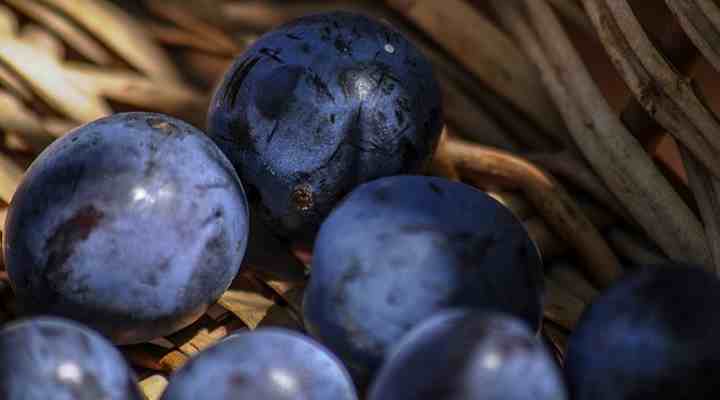
‘Black Splendor’ plums live up to their name—they have a fantastic sweet taste. The skin of these sweet plums is dark violet, and the waxy coating gives them a smoky appearance. Biting into these delicious stone fruits reveals a dark burgundy flesh that covers the large pit in the middle.
One of the beauties of ‘Black Splendor’ plums is that they are a large variety of plum that ripens early in the season. Hints of tartness from the black skin combined with the sweetness of the beet-colored flesh make these plums a variety to look for.
El Dorado
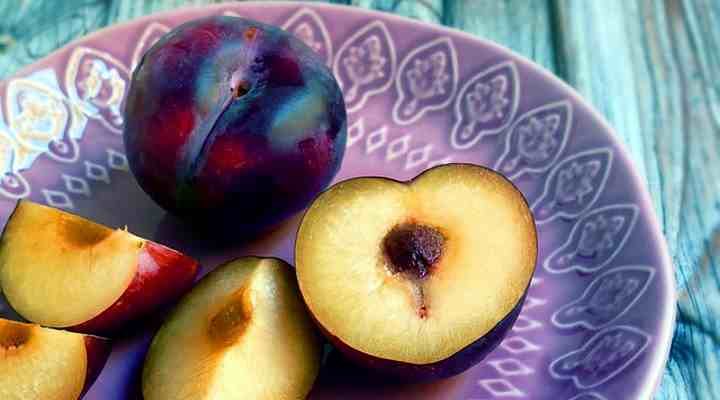
Another type of sweet black plum is the ‘El Dorado’ cultivar. Even with its firm amber-colored flesh, this plum has a sweet flavor. This plum variety is a great all-rounder as it’s one of the most versatile types of black plum you can grow. The firm flesh and tart skin holds up well in cooking and baking. The intensely sweet, juicy flesh also makes this a perfect plum for snacking on.
Black Amber
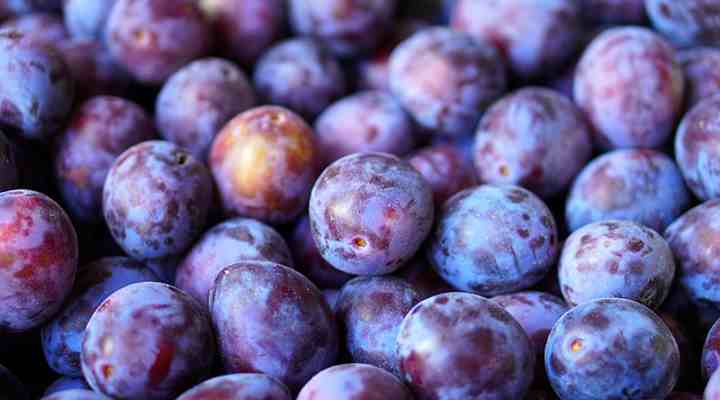
The ‘Black amber’ variety of plum gets its name from the black, slightly tart skin and juicy amber-colored flesh. Compared to other dark-skinned plums, the ‘Black amber’ has firm flesh and distinct tartness to the taste. The round plums have a bluish appearance due to the waxy coating that covers most types of prunes.
This plum cultivar is usually ripe for eating in mid- to late summer. You can use this plum in cooking as its firm flesh and sweet-sour taste adds flavor and texture to many dishes.
French Prune

The ‘French Prune’ is a type of fresh plum that is perfect for drying to make prunes. The drupe fruit has a long, oblong shape similar to a small pear. The dark, smokey skin has hues of purple and light blue that covers dark amber flesh. The French Prune Plume tree produces fruit that is ready for harvesting in late summer. The most popular variety in the United States is the ‘Improved French Prune’ that makes some of the finest and sweetest prunes you can eat.
Italian Prune Plum
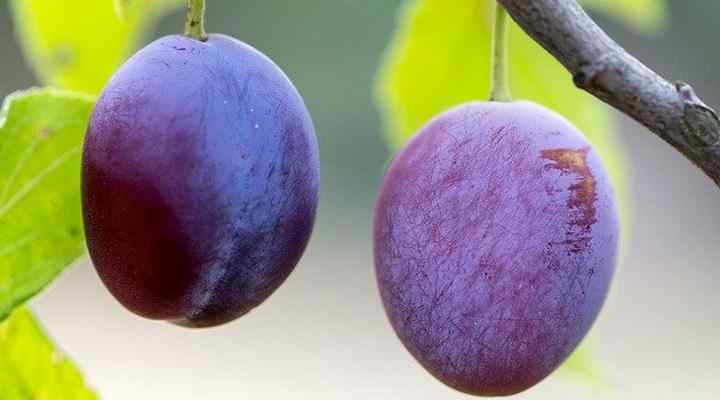
Similar to the French Prune, the Italian prune variety is a large, oblong, egg-shaped plum with a powdery coating on purple-blue skin. This freestone plum variety has green-amber juicy flesh that turns a deep fuchsia color when cooked. As the fruit ripens on the plum tree, its sweetness intensifies.
Although Italian prune plums are suitable for eating fresh, most of the harvest is dried to create prunes.
Sometimes dark-skinned Moyer plums are sold as Italian prunes or French prunes.
‘Owen T’ Plums
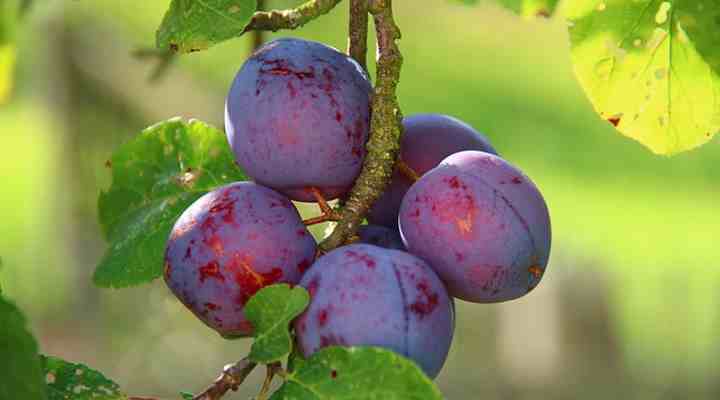
If you are looking for the largest type of plum, then the ‘Owen T’ cultivar is thought to be the biggest. A single plum can weigh up to 8 oz. (230 g) and measure a whopping 3” (7.5 cm) across. These large plums have bluish-dark purple skins surrounding sweet flesh that is a light yellow color. ‘Owen T’ plums are usually ready for eating in mid-season.
‘John W’ Plums
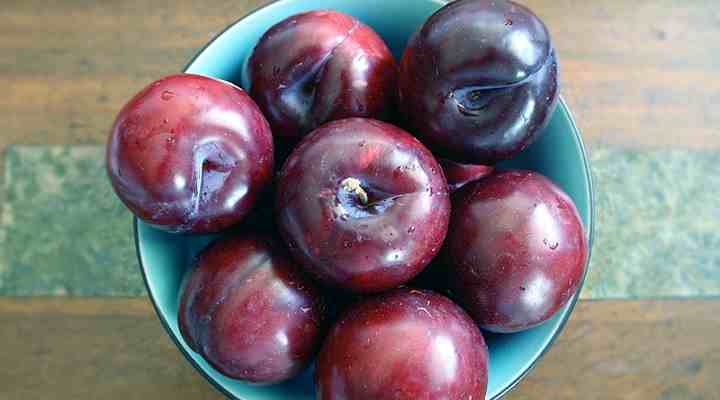
The other type of massive dark-skinned plum is the ‘John W’ cultivar. This plum cultivar is similar to the ‘Owen T’ variety in size. The difference between these two cultivars is skin and flesh color. The ‘John W’ plum variety has deep red-purple colored skin that surrounds deep orange flesh. These plums ripen later in the season than ‘Owen T’ plums.
Related articles:
- Types of Peaches: Freestone, Clingstone and More
- Types of Citrus Fruits With their Picture and Classification
- Types of Cherries: Varieties of Sweet and Tart (Sour) Cherries
